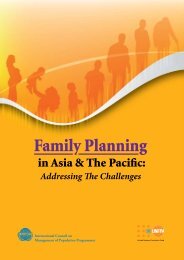SRH and HIV/AIDS Linkages at Policies, Programmes and Service ...
SRH and HIV/AIDS Linkages at Policies, Programmes and Service ...
SRH and HIV/AIDS Linkages at Policies, Programmes and Service ...
You also want an ePaper? Increase the reach of your titles
YUMPU automatically turns print PDFs into web optimized ePapers that Google loves.
grass-roots based service deliveryinfrastructure available all over thecountry. At n<strong>at</strong>ional level there is theInstitute of Post Gradu<strong>at</strong>e Medicine<strong>and</strong> Research, the M<strong>at</strong>ernal <strong>and</strong> ChildHealth Institute (MCHTI), theInstitute of Child & Mother Health(ICMH) <strong>and</strong> 13 government medicalcollege hospitals. The services offeredare anten<strong>at</strong>al, pren<strong>at</strong>al (delivery)including comprehensive EOC services<strong>and</strong> postn<strong>at</strong>al care for mother <strong>and</strong>childcare. At district level, 57 districthospitals provide anten<strong>at</strong>al <strong>and</strong> deliverycare including comprehensive EOCservices, postn<strong>at</strong>al care, EPI <strong>and</strong> childcare services.There are 90 Mother <strong>and</strong> ChildWelfare Centres (MCWC) in thecountry situ<strong>at</strong>ed <strong>at</strong> the district, Upazila<strong>and</strong> Union level, providing anten<strong>at</strong>alcare, normal delivery services, postn<strong>at</strong>alcare, EPI, <strong>and</strong> child healthcare. Outof these 64 MCWCs also providecomprehensive EOC services. Themajor services provided in the 397Upazila health complexes throughoutthe country are anten<strong>at</strong>al care, normaldelivery, postn<strong>at</strong>al care, EPI, FP, healtheduc<strong>at</strong>ion, <strong>and</strong> child healthcare. Outof these, 40 Upazila Health Complexes(UHCs) also provide comprehensiveEOC services.There are 3,200 Constructed UnionHealth <strong>and</strong> Family Welfare Centres(UH & FWC) in the country. Theservices provided here are: anten<strong>at</strong>al(screening for “<strong>at</strong> risk” pregnancies<strong>and</strong> referrals), safe deliveries throughdomiciliary follow up, postn<strong>at</strong>al care,health educ<strong>at</strong>ion <strong>and</strong> child care. Thepresent government has plans to st<strong>at</strong>iongradu<strong>at</strong>e doctors in all UH <strong>and</strong> FWCsin phases.Every month about 30,000 “s<strong>at</strong>elliteclinics” are organised <strong>at</strong> ward <strong>and</strong>community levels all over the countryto bring service facilities to the people.These include anten<strong>at</strong>al care, familyplanning, health educ<strong>at</strong>ion <strong>and</strong> EPIservices. The services are complementedby approxim<strong>at</strong>ely 23,000 family welfareassistants <strong>and</strong> 15,000 health assistantsworking <strong>at</strong> grass root levels for basichealth <strong>and</strong> family planning servicedelivery.The <strong>SRH</strong> situ<strong>at</strong>ion in Bangladesh canbe easily understood from the tablebelow (table 1) which shows the currentst<strong>at</strong>istics of key RH indic<strong>at</strong>ors.1.2 <strong>HIV</strong> <strong>and</strong> <strong>AIDS</strong>Programme inBangladeshIn the Asia-Pacific region which hasthe second highest number in the worldof people living with <strong>HIV</strong>/<strong>AIDS</strong>,Bangladesh is fortun<strong>at</strong>e to be one ofthe countries where the prevalence r<strong>at</strong>eof <strong>HIV</strong> infection is low. Since the firstcase of <strong>HIV</strong> was reported in 1989,about 1,745 cases were reported as of30 th November 2009. The estim<strong>at</strong>ednumber of people living with <strong>HIV</strong> inBangladesh was about 7,500 in 2007.According to UN<strong>AIDS</strong> the number ofpeople living with <strong>HIV</strong> in the countrymay be as high as 12,000 which is withinthe range of ‘low estim<strong>at</strong>e’ by UNICEF’sSt<strong>at</strong>e of the World’s Children Report2009.Although Bangladesh is still a lowprevalence country for r<strong>at</strong>e of <strong>HIV</strong>7














